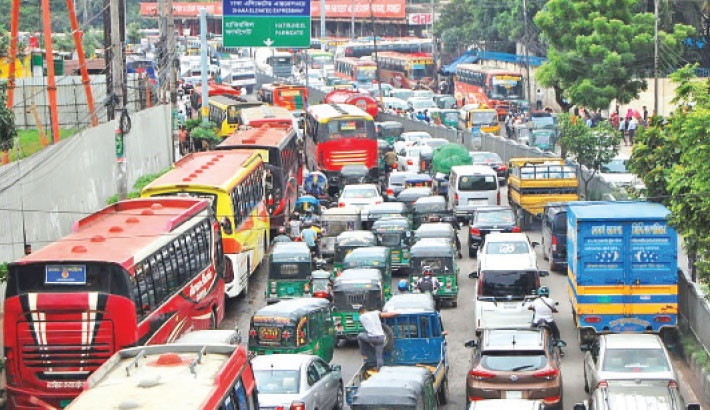Traffic congestion grips Dhaka
Metro rail closure adds to commute woes
Daily Sun Report, Dhaka
Published: 20 Aug 2024

The capital city witnesses acute traffic congestion on Monday, causing immense suffering for commuters. The photo was taken from Tejgaon area. -Daily Sun PHOTO
Commuters in the capital faced severe traffic congestion on Monday at various important points due to the reopening of educational institutions in full swing and protests to press home various demands held in several places.
Visiting several areas of the capital, including Shahbagh, Mirpur Road, Farmgate, Bijoy Sarani, Karwan Bazar, Banglamotor, Mogbazar, and Motijheel, this correspondent witnessed nagging traffic congestion during most times of the day.
Though classes at educational institutions resumed fully on Sunday, the presence of students on the roads increased on Monday. The resumption of full-fledged operations at public and private offices also increased the number of commuters on the roads. At the same time, the suspension of metro rail services intensified traffic jams in the city.
Meanwhile, protesters took positions on the streets in various parts of the city, making demands on a range of issues. In many locations, people staged sit-ins, exacerbating the traffic situation. In particular, Shahbagh saw a significant increase in traffic congestion as protesters blocked the roads, leading to a ripple effect on surrounding areas.
Similar gridlock was reported around Ramna and Motijheel, contributing to a near-total paralysis of Dhaka’s traffic flow.
Heavy traffic pressure was observed in Pragati Sarani, with gridlock in both directions near Jamuna Future Park. Vehicles were stuck in long queues, particularly at Bashundhara Residential Area’s main gate. Nearby lanes connected to Bashundhara R/A, Pragati Sarani, and Kuril also experienced a heavy flow of traffic.
The combined effect of these disruptions led to widespread gridlock, leaving commuters stranded and creating a sense of near-immobility across the city.

